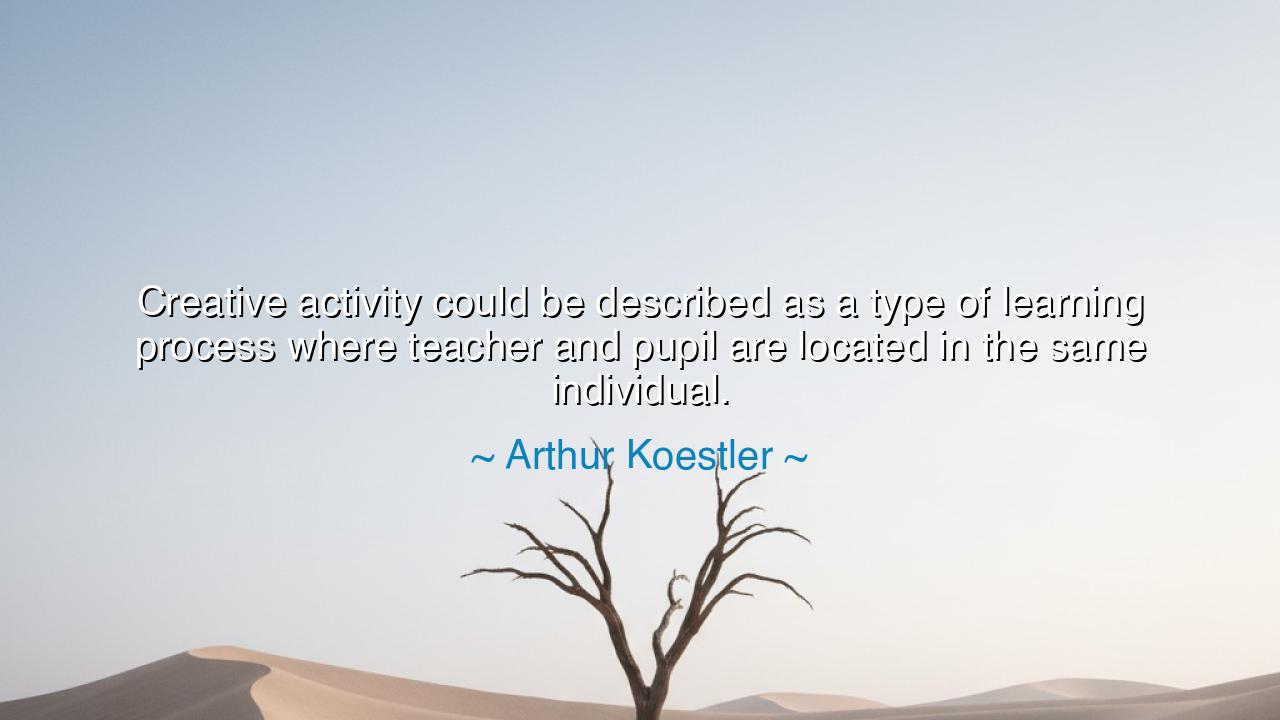
Creative activity could be described as a type of learning
Creative activity could be described as a type of learning process where teacher and pupil are located in the same individual.






“Creative activity could be described as a type of learning process where teacher and pupil are located in the same individual.” — Arthur Koestler
In these profound and radiant words, Arthur Koestler, the philosopher of imagination and reason, unveils one of the deepest mysteries of the human spirit — the act of creation as both instruction and awakening. He teaches that the artist, the inventor, the dreamer — all who create — are both student and master in the same breath. When the soul sets out to create, it becomes a classroom of its own making, where curiosity guides the hand, and discovery becomes the lesson. The teacher and pupil live as twins within the same mind: one questioning, one answering; one daring, one revealing. To create, then, is not simply to make — it is to learn oneself into being.
The ancients would have called this divine dialogue anamnesis — the “remembering” of truths already written upon the soul. Plato taught that all learning is a kind of recollection, a rediscovery of wisdom that has always lived within us. Koestler’s vision echoes this timeless idea: when we engage in creative activity, we awaken that inner teacher who has long slept beneath the surface of daily life. The artist learns by doing, but what is revealed through doing is not foreign knowledge — it is the deep, ancient knowing of the self. Thus, to create is to remember who we are.
Think of Leonardo da Vinci, that great master whose mind bridged art and science. In his journals, he wrote of endless experiments — sketches of wings, studies of water, dissections of anatomy — each line a conversation with himself. In the act of creation, Leonardo was both student and instructor. He learned from his own errors, questioned his own assumptions, and taught himself through relentless curiosity. Each invention, each drawing, was a moment of learning disguised as art. He did not separate study from inspiration, nor knowledge from wonder. In his mind, creativity was not an end — it was a sacred process of self-education, a dialogue between what he knew and what he longed to understand.
Koestler’s insight reminds us that every act of true creation is an act of transformation. When we paint, write, compose, or design, we are reshaping not only the world, but ourselves. The pupil within us approaches the blank canvas in awe, trembling before the unknown; the teacher within us guides the hand with wisdom born of experience and intuition. And in the meeting of these two — in their collaboration and struggle — something divine emerges: insight. The mind expands, and in that expansion, we become more than we were before. Creation, then, is the soul’s way of learning through revelation.
This inner balance of teacher and pupil is not reserved for artists alone. Every person who seeks to grow, who strives to understand, lives this duality. The craftsman shaping wood, the scientist decoding a pattern of stars, the gardener tending the soil — all are engaged in the same sacred process. They question, experiment, err, and discover. They teach themselves through their failures and learn through their persistence. To live creatively is to live as both question and answer, to be both seeker and sage.
Even Koestler himself, a man of science and letters, lived this truth. His studies of creativity were not distant or clinical — they were confessions of experience. He saw that every breakthrough, every spark of genius, begins as an internal dialogue between the known and the unknown, between knowledge and mystery. The mind that dares to create steps into uncertainty, trusting that wisdom will emerge from the very act of trying. In this way, creation is both discovery and instruction — a sacred experiment in the laboratory of the soul.
The lesson is clear: never separate learning from creating. When you write, paint, build, sing, or dream, know that you are teaching yourself something that no book can contain. Let your failures be lessons, your discoveries be teachers, and your curiosity the eternal pupil within you. Each act of creation is a dialogue with your deeper self — a whisper between who you are and who you are becoming. So create bravely, without fear of imperfection. For in every stroke, every idea, every attempt, you fulfill Koestler’s eternal truth: that within each of us lives both the teacher and the pupil, forever entwined in the art of becoming.






AAdministratorAdministrator
Welcome, honored guests. Please leave a comment, we will respond soon